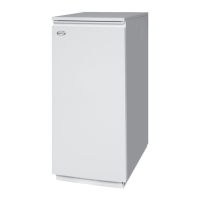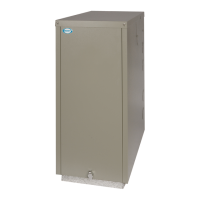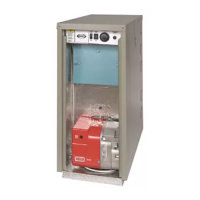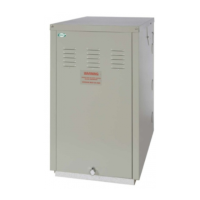20
7.2 System Models
All System models have the following
sealed system components factory
fitted (refer to Figure 7-3):-
• A diaphragm expansion vessel
complying with BS 4814, pre-
charged at 1.0 bar. Refer to
Section 2.2.
• System pressure gauge, with an
operating range of 1 to 4 bar.
• Pressure relief safety valve
complying with BS 6759 and set to
operate at 2.5 bar.
• Automatic air vent, fitted to the
flow pipe of the boiler, ensures the
boiler is vented.
• Filling loop. This must be isolated
and disconnected after filling the
system.
Refer to Section 2.2 for system volumes
and BS 7074: for further guidance and
for further details of the expansion
vessel.
The expansion vessel fitted, is supplied
with a charge pressure of 1.0 bar
(equivalent to a maximum static head of
10.2 metres). The charge pressure must
not be less than the actual static head
at the point of connection.
The central heating system volume,
using the expansion vessel as supplied,
must not exceed the recommended
value. Refer to Section 2.2. If the system
volume is greater, an extra expansion
vessel (complying with BS 4841) must
be fitted as close as possible to the
central heating return connection on the
boiler.
The charge pressure of the extra vessel
must be the same as the vessel fitted in
the boiler.
Refer to either BS 7074:1:1989 or
The Domestic Heating Design Guide
for the required total expansion
vessel volume for the system
concerned.
7.3 Fill the Sealed System
Automatic air vent(s) are fitted to the top
of the boiler (see Figure 7-3). Check that
the small cap on the top of each air vent
is screwed on fully, then unscrew it one
complete turn - the cap remains in this
position from now on.
The procedure for filling the sealed
system is as follows:
1. Only ever fill or add water to the
system when it is cold and the
boiler is off. Do not overfill.
2. Ensure that the flexible filling
loop supplied with the boiler is
connected and that the double
check shut off valve connecting it
to the water supply is closed.
A valve is open when the operating
lever is in line with the valve, and
closed when it is at right angles
to it.
3. Open the fill point valve.
4. Gradually open the double check
valve from the water supply until
water is heard to flow.
5. When the white needle of the
pressure gauge is between 0.5 and
1.0 bar, close the valve.
6. Vent each radiator in turn, starting
with the lowest one in the system,
to remove air.
7. Continue to fill the system until the
pressure gauge indicates between
0.5 and 1.0 bar. Close the fill point
valve.
8. Repeat steps 4 and 5 as required.
9. Close the fill point and double
check valves either side of the
filling loop and disconnect the loop.
7.4 Pressure Relief Safety
Valve
Now the pressure relief safety valve
operation must be checked and set. The
procedure is as follows:
1. Check the operation of the
safety valve by turning the head
anticlockwise until it clicks. The
click is the safety valve head lifting
off its seat allowing water to escape
from the system
2. Check that the water is escaping
from the system.
3. Continue to fill the system until the
pressure gauge indicates between
0.5 and 1.0 bar.
4. Close the fill point valve and check
the system for water soundness,
rectifying where necessary.
5. Water may be released from the
system by manually operating the
safety valve until the system design
pressure is obtained. The system
design pressure (cold) should be
between 0.5 bar and 1.0 bar.
The pressure is equivalent to the
maximum static head in bar + 0.3 (1
bar = 10.2 metres of water), where the
static head is the vertical height from
the centre of the expansion vessel to the
highest point of the system.
Now close the valves either side of the
filling loop and disconnect the loop.
!
CAUTION
Do not pressurise the vessel above
1.5 bar.
!
NOTE
The air pressure in the vessel must
be checked annually.
!
NOTE
The air charge pressure may be
checked using a tyre pressure
gauge on the expansion vessel
Schraeder valve. The vessel may
be re-pressurised using a suitable
pump. When checking the air
pressure the water in the heating
system must be cold and the system
pressure reduced to zero.
